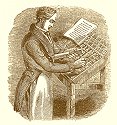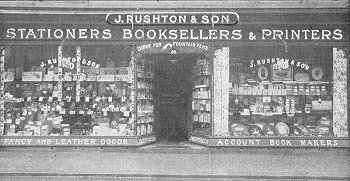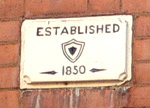 |
Wolverhampton Printers
A short history - page 1
|

|
Wolverhampton’s monastery would probably have had some sort of
scriptorium – a small one where the church's documents could be written
out on parchment. It does
not appear to have been a centre of manuscript production.
The lay people living round about would not have done much
writing – estate accounts and the occasional legal document. All our earliest documents, such as the charters, are
parchment and ink.
Printing was introduced into the country by Caxton in about 1473 and
gradually expanded. But the
presses were tightly controlled by the government and for almost two
hundred years the only places in which anything was printed were London,
Oxford and Cambridge. Their
output was mainly religious texts, classical works and a large number of
law books. During the
disturbances of the 17th century there were periods when many
political tracts were published.
The general expansion of printing beyond the three cities began
towards the end of the 17th century when presses were set up
in many cities and larger towns.
But the type of material they produced remained largely religious,
classical, governmental and legal.
Literacy was not widespread and most towns did not have a
literate population large enough to sustain a printing press.
It was largely economic expansion, the agricultural and
industrial revolutions, which changed the position.
Not only was there a great increase in the population generally,
including great increases in the size of towns, and a general increase
in literacy rates, but there was a commercial and industrial demand for
printed material.
The first book known to have been printed in Wolverhampton was
produced by George Wilson in 1724.
He, and his wife, Mary Wilson who succeeded him, produced a
number of books. This
suggests that they had a pretty good press and a reasonable stock of
type and it is likely that they were finding a sufficiency of commercial
work to be done, even before 1724.
By 1760 another printer, Thomas Smith, is found in
operation and, at the same time Joseph Smart appears on the
scene. He was not only a
printer but an editor and publisher of books, a book seller and a centre
of Wolverhampton’s literary life.
He and his succesors, who included William Parke,
continued printing until about 1833.
As the industrial revolution took a grip in the 19th
century the demand for commercial and industrial printing increased.
Increasing political activity with the widening of the franchise
and with the extension of local government increased the call for
printed material. There was
also a great increase in non-fiction works and the rise in fiction to be
allowed for. Newspapers
started to be regularly published and to flourish from the late 18th
century onwards.

Concert programme by F. Jones, of King
Street. 1863. |
In about 1811 Thomas Simpson appears as a
printer and he seems to have operated on a large scale.
He was succeeded by his son, another Thomas Simpson, who
eventually took into partnership John Steen, who
continued in business under his own name, his firm becoming one
of the largest in Wolverhampton, even taking over Edward Roden’s
business when he retired.
Another printer, whose output also included books, was J.
Bridgen who seems to have been the first to introduce colour
printing to the town.
At what date he did this is not recorded but his first book was
printed in 1831.
Edward Roden seems to have set up his business in
Wolverhampton in 1848.
He not only printed to a higher standard than those who had gone
before him but was a successful inventor of printing equipment. |
| The rapidly expanding town had a rapidly expanding
demand for print of all sorts.
This was met by the expansion of existing firms and the setting
up of new ones.
Alfred Hinde set up in 1856 and became one of the town’s
biggest printers.
But we find references to other printers too during the
latter part of the 19th
century such as A. J. Caldicott, J. Hildreth & Son, Hildreth and
Chambers, J. Heighway, Price and Williams, Richards & Cope, B.
Rowlands, J. A. Roebuck.
Although the bulk of their trade would have been jobbing
printing – printing anything the private customer or the
industrial or commercial customer might want – they would from
time to time print (and possibly bind also) books mostly of the
religious variety, but also some law books, trade directories,
trade catalogues, local guides books, and even slim volumes of
verse. |

A legal text book, printed
by Barford and Newitt who were at 27 Queen Street. |

A Sunday school prize book label by
George Goodwin, Queen Street. |
Some of these would have been printed for
booksellers or other sorts of publishers, some for the authors
themselves who would then circulate them however they wished,
but some would be printed for the printer himself to publish.
In times when, if you wanted more than a very few copies of
any written material, printing would be the cheapest and
quickest way to produce them, all sorts of material was printed
– for example, we know that one local worthy, when applying for
a new job, had his cv printed and produced as a book; it is
unlikely that he was alone in this.
But the bulk of their work would be visiting cards, business
cards, letter heads, all sorts of commercial stationery,
posters, commercial and political.
Sometimes they would venture out into printing and publishing
newspapers or magazines; or they would print them for others. |

Rushtons shop (it seems to be at 60
Queen Street) shows the range of goods and services which a
local printer, bookseller, book binder and general stationer
would supply. The prize book plate would be a stock item
for the shop. |
 |
This seems to be a purpose built printing house.
It is in Wheeler's Fold. Does anyone know anything about it?
Which company operated from here?
|
 |

|
|
Return to the
Printing Hall |
Proceed to
page 2 |
|










